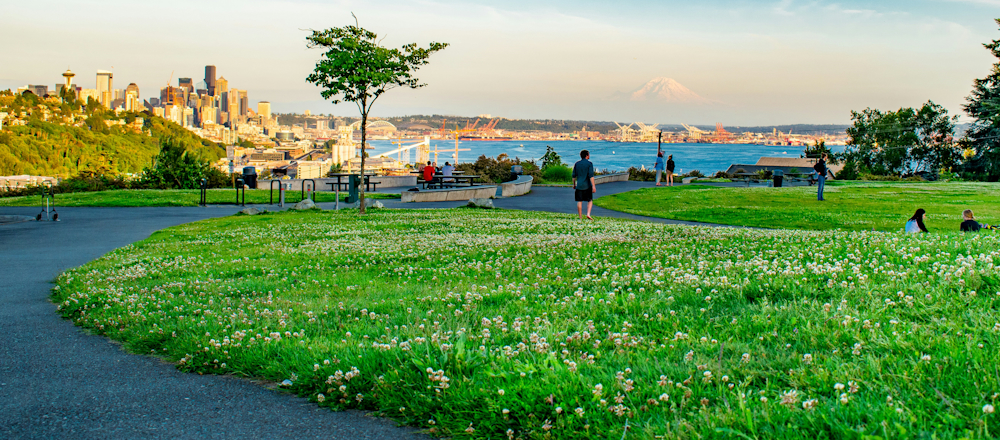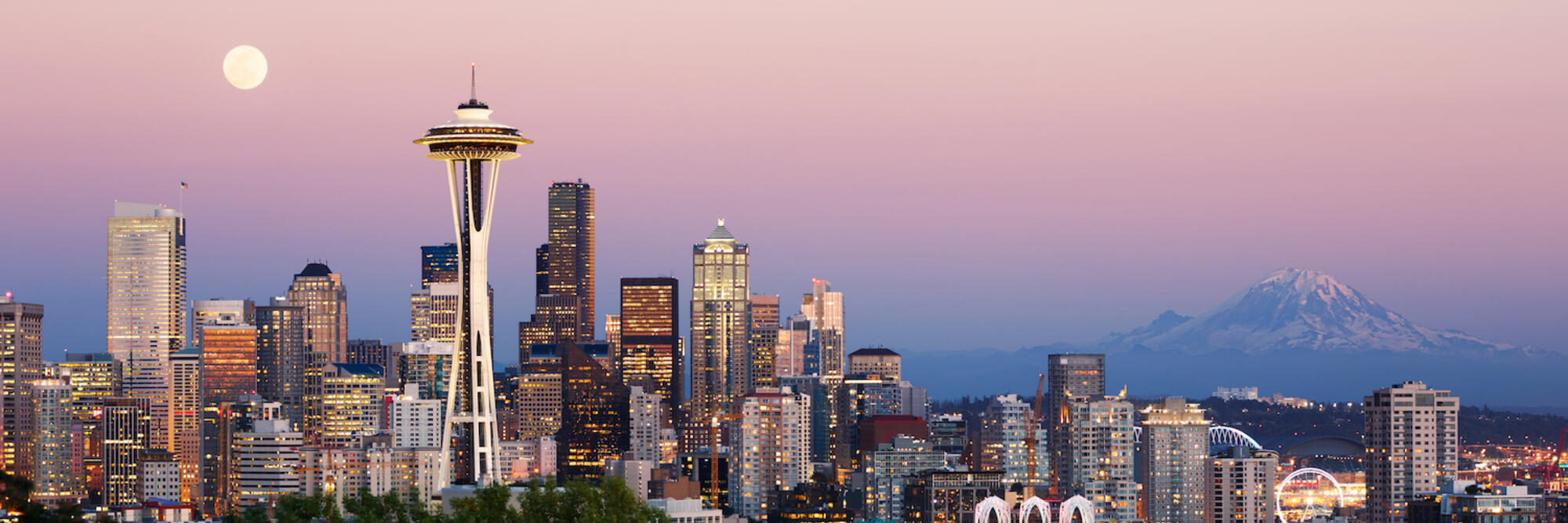- Download our Moving to Seattle Guide (PDF)
Seattle is one of the most picturesque cities in America, where majestic mountains and verdant forests are always in the frame. Locals understandably love the pristine natural beauty on their doorstep. The city is well known for its introverted and polite, if reserved, culture – most people would rather chat over drinks or go to the theatre than have wild nights on the town.
That said, like in every city, living in Seattle has a few drawbacks to go with its many advantages. Below is a list of the pros and cons of moving to Seattle.
Cost of living in Seattle
+ PRO: High spending power
Seattle’s resilient economy means professionals can earn more than the average American salary. This provides high spending power in Seattle, although it is often necessary to offset the steep cost of living.
- CON: High cost of living
While Seattle’s job market has cooled and unemployment has ticked slightly above the national average, the high cost of living in Seattle remains a significant factor. Affordability has been stretched. Healthcare and transport are considerably above the national average (by roughly 28 percent and 30 percent, respectively), while groceries cost around 11 percent more than they do in the rest of the country. Utilities, however, are generally on par with the national average.
Accommodation in Seattle
+ PRO: Excellent standard of accommodation
You will find an excellent standard of accommodation in Seattle, regardless of your walk of life. Young and single new arrivals looking to be in the hustle and bustle of downtown or South Lake Union will find plenty of modern housing, from loft conversions to chic apartments. Families typically find more spacious homes in Seattle’s highly rated outlying suburbs, such as Bellevue or Redmond. Be sure to research commute times, as many suburbs rely on bus networks or ferries rather than the light rail.
- CON: Rent costs are high
Housing doesn’t come cheap in Seattle, and rent costs are high. The cost of renting is roughly double the national average, driven by an influx of high-earning tech professionals and a persistently low vacancy rate. While there has been a boom in luxury apartment construction, this has led to a complex market: as of 2025, one-bedroom rents have been rising, while rents for larger two-bedroom units have seen a slight decrease.
Best and Worst Neighbourhoods to Live in Seattle
Renting Accommodation in Seattle
Working in Seattle

+ PRO: Job opportunities are broad
Thanks to its resilient economy, job opportunities are broad for those working in Seattle. The city’s unemployment rate remains low, although job growth has recently slowed and stabilised. The economy is heavily anchored by its key industries, especially tech (including AI, cloud infrastructure, and e-commerce), alongside aerospace and healthcare. Professional services and education are also major employers.
- CON: The job market is competitive
Seattle has its share of work opportunities, but the job market is highly competitive and can be a tough nut to crack. Many top employers are looking for the best of the best. If you want to succeed, networking is paramount. Referrals are king; mass applications sent via job boards are often filtered out by automated systems, so building connections through professional groups and LinkedIn is the most effective way in.
Lifestyle in Seattle

+ PRO: Outdoor activities are plentiful
The lifestyle in Seattle is defined by the outdoors, and outdoor activities are plentiful. Vast acres of parkland, like the 534-acre Discovery Park, mean that if you’re active, you can easily find superb hiking and biking trails right in the city. Climbers flock to Mount Rainier National Park, while Lake Washington is a top spot for bass, trout and salmon fishing. Camping, skiing, whale watching, and visits to the nearby islands are on the menu too.
+ PRO: Great culinary scene
The city’s great culinary scene offers everything from expensive high-end fare to moreish food truck bites. Seattle’s seafood options are particularly appetising, from Pike Place Market chowder to fresh oysters. You’ll also find the classic Pacific Northwest tradition of magnificent breakfasts. The city has a stellar reputation in the craft brewing industry and is home to world-renowned artisans who microbrew beer and roast coffee.
+ PRO: Thriving music scene
Seattle has a real pedigree as a thriving music scene. Renowned artists such as Ray Charles and Quincy Jones started their careers here. The grunge genre traces its origins to the city through bands like Pearl Jam, Nirvana, and Soundgarden. Today, you can enjoy a resurgent grunge-influenced sound, an active live jazz scene, and active hip hop and classical communities.
- CON: The Seattle Freeze
Many people who move to the city experience the ‘Seattle Freeze’ as a form of culture shock in Seattle. This refers to the local tendency to be polite and friendly in passing, but also noncommittal and difficult to build deep friendships with. Newcomers often find that casual invitations to ‘hang out sometime’ rarely turn into firm plans.
The most common advice from locals and successful transplants on forums is to be proactive. Building a social circle often means joining interest-based groups, such as social sports leagues or hobby-specific Meetup groups, rather than waiting for spontaneous invites.
+ PRO: Abundant indoor culture
When the famous rain sets in, the city’s indoor lifestyle thrives. You can visit world-class museums, such as the Museum of Pop Culture (MoPOP) or the Seattle Art Museum. The Seattle Aquarium showcases local marine life, while the city’s legendary coffee shop and independent bookshop scene makes for countless cosy refuges from the weather.
Education in Seattle
+ PRO: Highly rated schools and universities
For families, there are excellent options for education in Seattle, particularly in the private sector and in affluent suburbs like Bellevue and Mercer Island. The city is home to world-class private schools (such as Lakeside) and several highly specialised public programmes. It is also a major hub for higher education, anchored by the globally renowned University of Washington (UW).
- CON: Inconsistent public school system
Despite the city’s wealth, the Seattle Public Schools system grapples with real challenges. Parents express frustration with funding inconsistencies, enrolment lotteries, overcrowding, and a gap in quality and resources between schools in different neighbourhoods. This often pushes families to either move to a specific, high-demand catchment area or budget for private school tuition.
Schools and Education in Seattle
Safety in Seattle
+ PRO: Low violent crime rate
When it comes to safety in Seattle, it’s a tale of two cities. Compared to many other major US cities, Seattle’s violent crime rate is relatively low. Homicide rates, for example, have been trending downward in 2024 and 2025 from their pandemic-era highs. Most residential neighbourhoods, particularly in the north, are considered very safe.
- CON: High and persistent property crime
The city’s primary safety issue is its exceptionally high rate of property crime. Car break-ins, package theft, and burglaries are a persistent source of frustration for residents. Official statistics confirm that Seattle’s burglary rate is one of the highest in the country. Perceptions of public safety, particularly downtown, are also low due to visible homelessness and open drug use.
Weather in Seattle

- CON: The persistent gloom
For all the city's virtues, the weather in Seattle can be a challenge. The city averages only 152 days of sunshine per year (versus a US average of 205). It’s a common misconception that Seattle is one of America’s rainiest cities; in fact, it actually gets less total rainfall than New York City or Miami. The reality is a persistent, light drizzle and near constant cloud cover for much of the year, particularly from October to April.
This ‘Big Dark’ can be a difficult adjustment. Locals learn to cope by investing in excellent waterproof gear (locals scoff at umbrellas), taking vitamin D supplements, and in some cases, using a SAD (Seasonal Affective Disorder) lamp to combat the gloom.
+ PRO: Mild seasons and beautiful summers
Although the winters are grey, the city enjoys a comfortable climate for most of the year. Winter temperatures are generally mild and rarely drop to extremes. Snowfall is minimal, averaging less than seven inches (18cm) annually, so the city rarely grinds to a powdery halt.
When the sun finally arrives in July, Seattle’s summers are famously beautiful and considered near perfect. A significant modern con, however, is the increasing frequency of extreme summer heatwaves and wildfire smoke. These events can be dangerous, as many older homes and apartments were built without air conditioning.
